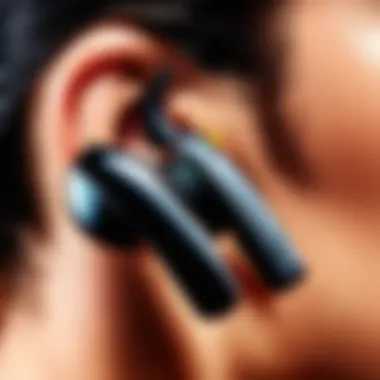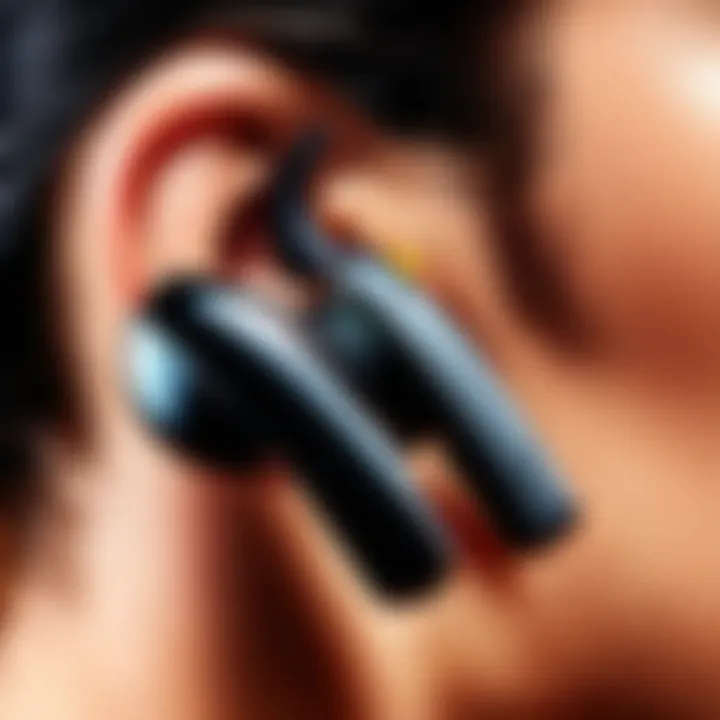In-Depth Overview of Wireless Earbud Varieties


Intro
In the bustling world of personal audio, wireless earbuds have made waves that go far beyond just convenience. From bustling city streets to serene park strolls, there’s a set of earbuds tailor-made for every situation. Whether you’re a gym enthusiast who thrives on high-energy beats, a professional who prioritizes crystal-clear calls, or simply someone who enjoys the soothing tones of a favorite playlist, the options can be overwhelming.
This comprehensive analysis breaks down the various types of wireless earbuds on the market, aiming to illuminate the unique features and advancements found in each category. Today, we’ll cover not only the technical specifications that define these devices, but also practical applications, comparisons, and the latest trends shaping the industry. This guide will help tech-savvy consumers, gamers, PC builders, and everyday users navigate the crowded and ever-evolving landscape of wireless audio technology.
Let’s dive into the first of many insightful sections, starting with the key technical specifications that differentiate the earbuds available today.
Technical Specifications
Understanding the technical side of wireless earbuds is essential for grasping their performance and suitability for various tasks.
Detailed Product Specs
When looking for wireless earbuds, one should consider several specifications:
- Battery Life: Ranging from a few hours to more than twenty, it determines how often you need to recharge.
- Driver Size: Larger drivers typically provide better sound quality, but size isn’t everything.
- Bluetooth Version: Newer versions offer better connectivity and battery efficiency.
- Water Resistance Rating: For those who sweat or are likely to be caught in the rain, this is crucial.
Performance Metrics
Performance is not just about the specs on paper, it’s about how those translate into actual usage:
- Sound Quality: How well do they reproduce music? Bass, mids, and highs need to be balanced.
- Noise Cancellation: Active and passive noise cancellation features vary significantly; some are designed to provide total isolation, others might let in ambient sound for a safer experience outdoors.
- Call Clarity: Important for professionals; some earbuds perform poorly during calls if they lack adequate microphones.
Compatibility Information
Compatibility can be a make-or-break factor.
- Device Pairing: Most wireless earbuds pair seamlessly with smartphones, tablets, and laptops. However, the experience can vary with different brands and operating systems.
- Multi-Device Pairing: Not all earbuds support connecting to more than one device at a time; it’s worth checking this feature if you frequently switch between devices.
"The right pair of earbuds can transform an ordinary day into an extraordinary audio experience."
Having a grasp of these technical specifications will pave the way for making informed decisions as we explore product comparisons in the next section.
Preamble to Wireless Earbuds
The rise of wireless earbuds has revolutionized how people consume audio, from music to podcasts and everything in between. In today's fast-paced world, the way we listen matters more than ever. It's not just about sound quality; it's about convenience and connectivity. Wireless earbuds offer the freedom to move about without the hassle of tangled cords, which is a game changer for everyday use.
Evolution of Earbuds
From bulky headphones of the late 20th century to the sleek designs of today, earbuds have come a long way. Initially, they served a simple purpose of delivering sound. However, with advancements in technology, today’s earbuds offer a range of features that were once unimaginable. Take, for instance, the transition from wired to wireless technology. The first major leap came with the introduction of Bluetooth, allowing earbuds to connect to devices without a physical tether. Early models were somewhat limited, often criticized for poor battery life and sound quality. But, as technology improved, so did the performance of these devices.
For example, the emergence of true wireless earbuds eliminated all physical connections, using innovative charging cases for battery management which paved the way for convenience and portability. Nowadays, it's not unusual to see earbuds crammed with features like touch controls, voice assistants, and even fitness tracking capabilities. Each evolution marks a step towards creating a more integrated audio experience, making it essential for users to grasp where we started to fully appreciate today's offerings.
Importance of Wireless Technology
Wireless technology transforms how users interact with audio devices. Its significance can't be overstated. First and foremost, users appreciate the freedom that comes with wireless earbuds. Imagine cooking while listening to your favorite podcast without worrying about snagging a wire. Furthermore, the comfort of being able to move around freely while on a call can be quite liberating. This has significant implications for professionals who multitask.
In addition to personal convenience, wireless technology enhances the overall user experience. Features such as noise cancellation or spatial audio integration can be highly beneficial, depending on the environment in which the earbuds are used.
"The future of audio isn’t just in sound clarity; it's in how seamlessly we can integrate sound into our lives."
Moreover, as wireless standards evolve—like the move from Bluetooth 4.2 to 5.0—the capabilities and efficiency of earbuds improve. Better range, lower latency, and smoother connections are all part of the package, drastically improving user satisfaction. For tech-savvy consumers, these elements become not just preferences but expectations.
In summary, the introduction to wireless earbuds not only highlights their evolution but also underlines the monumental importance of wireless technology in shaping user experiences today.
True Wireless Earbuds
True wireless earbuds are more than just a trend; they represent a significant leap in audio technology, blending convenience with sound quality in a way that caters to modern lifestyles. These devices have gained traction for their ability to provide an untethered audio experience, making them ideal for a myriad of situations—be it during a morning jog or while multitasking at the office. The absence of wires not only enhances mobility but also adds to the overall aesthetic appeal.
Definition and Features
True wireless earbuds refer to small audio devices that connect to your music player or phone through Bluetooth, which means there are absolutely no wires connecting the left and right units. They're like the little brothers of traditional wireless earbuds, cutting out any cord fuss.
Some key features that set them apart include:
- Compact Design: These earbuds often come in a sleek casing, compact enough to fit snugly in your pocket.
- Impressive Battery Life: They typically feature charging cases which extend the overall playtime; you might see models offering up to 30 hours of use with their compact case.
- Intuitive Controls: Many true wireless earbuds have touch-sensitive surfaces for playback controls or voice assistant activation.
- Quality Audio Performance: The sound quality can vary, but premium models often boast rich audio profiles, dynamic range, and enhanced bass.
Overall, true wireless earbuds symbolize convenience, packing high-tech features into tiny gadgets that fit right in your ears.
Popular Models and Brands
When you think of true wireless earbuds, several brands spring to mind, each offering unique designs and functionalities:
- Apple AirPods Pro: With their adaptive EQ, active noise cancellation, and seamless integration with Apple devices, they are a strong favorite among iPhone users.
- Sony WF-1000XM4: Known for exceptional sound quality and industry-leading noise cancellation, these earbuds are often favored by audiophiles.
- Samsung Galaxy Buds Live: Their distinctive bean shape and open design cater to those who want comfort without sacrificing audio performance.
- Jabra Elite 75t: These provide customizable sound settings and reliable wireless performance, making them suitable for a variety of users.
Each of these models showcases innovations that cater to the specific demands of a tech-savvy audience, promising a myriad of audio experiences.
Use Cases and Compatibility
True wireless earbuds shine in numerous scenarios, demonstrating their versatility:
- Daily Commutes: They allow users to immerse themselves in their own audio world while navigating the hustle and bustle.
- Fitness Activities: Many models come with sweat and water resistance ratings, essential for runners or gym-goers.
- Multimedia: Whether watching a movie or gaming, these earbuds can often deliver low latency performance, which is a huge plus for gamers who need precise sound delivery.
Compatibility is generally broad, as they can connect to any Bluetooth-enabled device, including:
- Smartphones: iOS and Android devices typically pair easily.
- Tablets: Great for catching up on shows or work presentations.
- Laptops: Many true wireless earbuds connect with laptops for seamless video calls or gaming sessions.
In essence, true wireless earbuds offer an enormous amount of flexibility, aligning perfectly with various tech ecosystems.
Over-Ear Wireless Earbuds
Over-ear wireless earbuds often stand as the preferred choice for many audiophiles and casual listeners alike. Their unique design offers a blend of comfort and superior sound quality that sets them apart from their in-ear counterparts. In this section, we'll explore the features that make over-ear earbuds significant, identifying key elements that enhance user experience and functionality.
Characteristics of Over-Ear Design
The over-ear design typically envelops the ears completely, creating a physical barrier that aids in sound isolation. This design choice contributes to a few notable characteristics:
- Comfort: With larger ear cups often lined with memory foam, these earbuds provide extended comfort for long listening sessions. Unlike in-ear models, over-ears offer less pressure on the ear canal.
- Enhanced Audio Performance: Larger drivers can be integrated into over-ear earbuds, leading to more dynamic sound profiles. This means a richer bass response along with clearer highs and mids, catering to those who prioritize sound fidelity.
- Heat and Weight Considerations: While the added comfort is a plus, it's worth noting that these models can be heavier and warmer compared to in-ear designs. Adequate ventilation in the padding can alleviate heat build-up during prolonged use, but potential users should be aware of the trade-off.
Target User Demographics
Over-ear wireless earbuds appeal to a specific demographic, particularly those who prioritize audio quality. Here’s a closer look at potential user groups:
- Audiophiles: These individuals are likely to invest in high-quality sound equipment and are often found gravitating towards premium models that emphasize audio performance.
- Gamers: Gamers also appreciate the over-ear design, as it provides immersion into soundscapes, making it easier to discern 3D audio effects crucial for gameplay.
- Office Workers: With many now working from home, professionals favor over-ear options for comfort during long conference calls or video meetings, especially those requiring a quiet environment.
Noise Cancellation Features


Noise-canceling technology plays a pivotal role in shaping the over-ear listening experience. Here are important aspects to consider:
- Active Noise Cancellation (ANC): Many over-ear models come equipped with ANC, which uses built-in microphones to pick up surrounding noise and generates sound waves to cancel it out. This significantly enhances focus whether in an office or a noisy café.
- Passive Noise Isolation: The physical structure of over-ear earbuds contributes to passive isolation, blocking out ambient noise without the need for electronic aids. This feature is especially useful in environments where silence is golden.
- Adaptive Features: Some of the latest models feature adaptive noise cancellation, adjusting the level of outside sound interference based on the environment. This means enhanced user experience, allowing listeners to toggle between complete isolation and awareness of surroundings.
"The balance between sound quality, comfort, and noise cancellation makes over-ear wireless earbuds popular among diverse user groups."
In summary, over-ear wireless earbuds provide distinct advantages that cater to various user needs. Their unique characteristics, coupled with advanced noise cancellation features, make them a worthy consideration for anyone seeking an immersive audio experience.
Sports Wireless Earbuds
In the ever-evolving realm of audio technology, sports wireless earbuds hold a special place. They are not merely a fade or a trend; they address the needs of active individuals who demand both performance and convenience. With the rise of fitness trends and outdoor activities, these earbuds can significantly enhance the experience, bringing forth a blend of functionality and enjoyment. This section will dig into various facets of sports wireless earbuds, deciphering the benefits and considerations that can guide consumers in their choices.
Design and Durability
Design plays a pivotal role in the selection of sports wireless earbuds. Unlike standard earbuds, those meant for sports must contend with sweat, moisture, and dynamic movements. The best sports earbuds often feature a snug, ergonomic fit that ensures they stay put, even during rigorous workouts. Some brands, like Jaybird and Bose, utilize materials that are not only lightweight but also water-resistant, providing a practical safeguard against the elements.
A prime example is the Powerbeats Pro which incorporates ear hooks to keep them securely in place, making them suitable for running or high-energy gym sessions. Furthermore, design is about more than just securing the earbuds; it also encompasses user comfort during extended wear. A well-designed earbud should feel like a feather in one's ear, facilitating hours of use without discomfort, a crucial aspect for athletes and fitness aficionados alike.
Sound Customization for Runners
Every runner knows the significance of a solid auditory experience while pounding the pavement. Sports wireless earbuds often come with sound customization options that allow users to tweak audio settings according to their preferences or environmental conditions. Many models offer features such as adjustable sound equalizers or even ambient sound modes.
This can be especially handy; runners might want to keep environmental sounds in check for safety while still enjoying their music. For instance, the Sony WF-SP800N provides settings to modify noise cancellation and ambient sound to suit one’s running environment—whether on a busy street or a serene trail. This degree of customization can make each run not just bearable but also vastly more enjoyable.
Battery Life and Performance
Battery life is another cornerstone of sports wireless earbuds, setting the stage for a potentially unmatched experience. In the heat of training, few things are more frustrating than earbuds giving out halfway through. Therefore, manufacturers have taken strides to enhance battery longevity. High-performance models, such as the Jabra Elite Active 75t, boast up to 28 hours of battery life with the charging case—a reputable figure that surpasses many competitors.
Moreover, rapid charge options feature prominently today, where even a quick 15-minute charge might yield a few hours of playback. This ensures that forgetting to charge doesn’t put a damper on impulse workouts.
"The modern athlete needs earbuds that are as resilient and dynamic as their workout routine."
In summary, sports wireless earbuds are crafted with the active user in mind. They incorporate specific design traits, sound enhancements, and prolonged battery life to cater to fitness enthusiasts, transforming mundane workouts into exhilarating sessions. By understanding their unique attributes, users can select the best pair tailored to their active lifestyle.
Budget-Friendly Wireless Earbuds
In the sea of wireless audio options, budget-friendly wireless earbuds hold a significant spot, especially for those looking to enjoy quality sound without breaking the bank. The essence of affordable earbud options is their ability to offer a taste of advanced audio technology to everyday users. They make wireless audio accessible to a wider audience, ensuring that budget constraints do not lead to compromising on sound quality and features.
Not every user requires the high-end functionalities that come with pricier models. Many are simply looking for a reliable audio companion for daily commutes, workouts, or casual listening. Moreover, as technology progresses, manufacturers are able to introduce economical options that boast good performance and durability.
Economical Options Available
When sifting through budget-friendly wireless earbuds, it is essential to consider options that won’t disappoint. Brands like Anker Soundcore, TaoTronics, and Aukey offer economical earbuds without skimping on basic functionalities. These products typically come equipped with features such as:
- Bluetooth Connectivity: Generally supporting the latest Bluetooth standards for stable connections.
- Decent Battery Life: Average offerings range between 5 to 10 hours of playback time on a single charge.
- Comfortable Fit: Many models include different ear tip sizes to ensure a snug and secure fit during wear.
- Basic Water Resistance: While many don’t feature premium water resistance, a few options offer splash resistance for workouts.
Many times, these budget models come packed with features that rival some of their more expensive counterparts.
Features to Expect at Lower Price Points
Opting for budget-friendly earbuds does not necessarily mean sacrificing quality. Here are some features that can commonly be found in this price range:
- Acceptable Sound Quality: While they may not deliver audiophile-level sound, budget options can still provide good highs and mids, perfect for casual listening.
- Built-In Microphone: Most models include this function, allowing for hands-free calling, though there may be limitations in clarity.
- Simple Controls: Basic touch or button controls on the earbuds for music playback and calls.
- Lightweight Designs: Often prioritize portability and comfort, making them easy to carry around.
- Comfortable Ear tips: Many include various sizes and shapes to fit different users, enhancing the overall experience.
Comparative Analysis with Premium Models
When placed side by side with premium models, budget-friendly wireless earbuds exhibit both strengths and weaknesses. Analyzing these differences helps in understanding the true essence of what can be expected when choosing more affordable options.
Strengths
- Affordability: The most notable advantage is the cost, which often allows users to invest in multiple pairs or different styles for various activities.
- User-Friendly: Basic functionality typically means easier navigation for less tech-savvy consumers.
- Simplicity: In general, fewer features do not mean a stripped-down experience; it often leads to streamlined quality.
Weaknesses
- Limited Durability: Cheaper materials can lead to wear and tear faster than premium products.
- Sound Quality: While decent, the audio output may not compete with high-end counterparts that often excel at bass response and clarity.
- Battery Life: While many budget alternatives provide average battery life, premium options often offer advanced charging technology, leading to quicker recharge times.
In summary, budget-friendly wireless earbuds represent an essential segment of the audio market that caters to a broad consumer base. By understanding their features and shortcomings, users can make an informed choice that suits their auditory needs without emptying their wallets.
Premium Wireless Earbuds
In a market flooded with various audio devices, premium wireless earbuds stand out for their capacity to deliver superior sound quality and an elevated user experience. These earbuds often become the go-to choice for audiophiles, gamers, and those who simply value high-performance tech. Focusing on premium options provides insight into advanced features, unrivaled sound quality, and durable build that can make a world of difference in daily use.
High-End Features and Innovations
Premium wireless earbuds bring a suite of high-end features that set them apart from their more economical counterparts. Many models integrate cutting-edge technology in a compact design. Here are some key features:
- Adaptive Noise Cancellation: This technology uses microphones to detect outside noise and eliminates it, creating an island of serenity even in bustling environments.
- Spatial Audio: This feature offers an immersive sound experience, simulating a surround sound environment that enhances everything from music to movies.
- Touch Controls: With just a tap or swipe on the earbud surface, users can control playback, manage calls, or access voice assistants, merging convenience with modernity.
Investments in battery management and improved connectivity through the latest Bluetooth standards often accompany these earbuds, allowing for extended playtime and seamless pairing.
Audio Quality Assessment
When it comes to sound, premium wireless earbuds do not skimp. Audio quality is often assessed based on three primary components: clarity, bass response, and audio profile.
- Clarity: Higher-end models deliver crystal-clear highs, making voices and instruments distinct, avoiding muddiness that can plague lower-cost options.
- Bass Response: A deep, rich bass can elevate the music experience; premium earbuds often offer adjustable bass settings to tailor the sound according to personal preference.
- Profiles: Many of these earbuds allow users to switch between sound profiles. This functionality can enhance listening experiences whether one is enjoying classical music or pumping up for a workout.
It's important to explore user reviews and professional assessments to gauge how individual models perform in real-world scenarios. The nuances of audio engineering can sometimes be lost in generic descriptions.
Market Leaders in the Premium Segment
Numerous brands have established themselves as leaders in the premium wireless earbud market. Recognizing these can guide potential buyers to choose wisely:
- Apple AirPods Pro: They are lauded for their ease of use and integration within the Apple ecosystem. With features like spatial audio and excellent noise cancellation, these earbuds are a top choice.
- Sony WF-1000XM4: Known for industry-leading noise cancellation and sound quality, this model often garners rave reviews from audiophiles.
- Sennheiser Momentum True Wireless 2: These earbuds offer a rich sound experience and boast stylish design, hitting that sweet spot between functionality and aesthetics.
Each of these brands emphasizes innovation and customer satisfaction, setting the bar for competitors.
"Premium wireless earbuds are not just an investment in audio quality; they are a gateway to an unparalleled listening experience that can change how you perceive sound."
In summary, premium wireless earbuds encapsulate a blend of advanced technology, superior sound quality, and stylish design, making them a worthwhile consideration for anyone looking to enhance their audio journey.
Noise-Canceling Technology in Earbuds
Noise-canceling technology in earbuds has transformed the way users experience audio. As our surroundings become busier, finding moments of isolation can be problematic. This is where noise-canceling earbuds come into play, letting us enjoy our music, podcasts, or calls in peace. It’s all about how technology helps us carve out our own audio oasis in a noisy world.
Active vs. Passive Noise Cancellation
Active and passive noise cancellation both aim to improve the listening experience, yet they tackle the issue from different angles.


Active Noise Cancellation (ANC) is like an intricate dance between your earbuds and the environment. This method uses microphones to pick up external sounds, and then generates sound waves that are the exact opposite of these unwanted noises. In essence, they work against one another, enabling the user to focus on their audio without outside interruptions. This is particularly useful in environments like airplanes or busy streets.
On the flip side, Passive Noise Cancellation relies on the physical design of the earbuds to block out sounds. This might include snug-fitting silicone tips that create a seal in the ear canal—good old-fashioned physics at work. While it doesn’t cancel noise in the same sophisticated way as ANC, it can still offer considerable reduction in ambient sound, making it a solid choice for casual listeners.
Ultimately, deciding between active and passive noise cancellation comes down to personal preference. Some might favor the advanced technology of ANC and its effectiveness against harsher sounds, while others might appreciate the simplicity of passive solutions. Here are some key takeaways:
- Active Noise Cancellation
- Passive Noise Cancellation
- Utilizes microphones and sound waves.
- Great for loud environments.
- Typically requires higher battery consumption.
- Based on physical design.
- Simpler technology.
- Effective for casual listeners.
Impacts on Sound Experience
The impact of noise-canceling technology on sound experience can be both significant and nuanced. For one, when unwanted sounds are minimized, users often experience a more immersive atmosphere. Have you ever tried listening to music in a bustling café? It can be difficult to appreciate the intricate notes and heartfelt lyrics when there's chatter and clattering going on around you. Noise-canceling earbuds can turn that chaos into a serene backdrop, letting the rich details of the audio shine through.
Moreover, a quiet environment allows for a more dynamic range of sounds to be perceptible. Subtle bass notes that might have been lost to background noise become more noticeable, enhancing the overall quality of the listening experience.
However, it’s important to note that some users may feel uneasy when in total silence thanks to ANC. It can create a sensation of pressure in the ears for some folks, often referred to as the "earplug effect." To mitigate this, many brands are now incorporating adaptive ANC technology that adjusts levels based on ambient noise, providing a balance between awareness of the environment and audio enjoyment.
"Noise cancellation doesn't just mute sound; it transforms the way we connect with audio, catering to the needs of each user uniquely."
As the world continues to evolve, so does the technology that enables us to comprehend it through sound. Embracing that change can enhance not just our listening experiences, but also our everyday lives.
Bluetooth Technology and Connectivity
The realm of wireless earbuds would be a mere whisper in the vast tech universe without the advanced underpinnings of Bluetooth technology. It’s this clever little protocol that frees us from the shackles of tangled cords, allowing for seamless connection and uninterrupted enjoyment of our favorite tunes or podcasts. When exploring wireless earbuds, understanding Bluetooth technology ought to be at the forefront.
Understanding Bluetooth Standards
Bluetooth, in its many iterations, serves as the backbone for connecting wireless earbuds to devices such as smartphones, tablets, and laptops. Over the years, Bluetooth standards have evolved, enhancing functionality and improving user experience. Currently, Bluetooth 5.0 is one of the most popular versions, boasting a faster data transfer rate and an extended range. With Bluetooth 5.0, data can travel up to 800 feet in open space, which is quite a leap from its predecessors. This means you can leave your phone in one room while moving to another without missing a beat.
Key Aspects of Bluetooth Standards:
- Speed: Enhanced speed allows for higher-quality audio streaming without lag.
- Range: Longer ranges reduce the need for close proximity to devices, offering flexibility during use.
- Power Efficiency: Newer standards consume less power, helping earbuds conserve battery life.
These features not only heighten user satisfaction but also improve the overall performance of wireless earbuds, catering to the needs of various users. What’s more, earbuds support specific Bluetooth profiles, making it possible to connect with different devices and applications seamlessly.
Interference and Range Considerations
While Bluetooth technology is a marvel of modern connectivity, it does come with its set of challenges. Interference is one of the primary issues affecting wireless performance. Other devices that use radio frequencies, such as Wi-Fi routers or even microwaves, can disrupt the signals, leading to dropouts or reduced audio quality. Understanding these potential pitfalls can help users avoid frustrating experiences.
- Common Interference Sources:
- Wi-Fi routers operating on the same frequency band
- Microwave ovens
- Physical barriers like walls or large furniture
Additionally, the range is another factor that can greatly influence performance. Users should be aware that while Bluetooth 5.0 can theoretically maintain connections over long distances, actual performance might vary depending on obstacles and environmental factors.
"Bluetooth connectivity may seem straightforward, but understanding its nuances can significantly enhance your listening experience."
Finale
The importance of Bluetooth technology and its standards cannot be overstated when discussing wireless earbuds. From ensuring clear audio playback to navigating around potential interferences, a solid grasp of these elements can empower users to make the most out of their wireless audio experience. For tech enthusiasts, gamers, and everyday users, being informed is key in a landscape ever-changing with technological advancements.
User Preferences and Ergonomics
Understanding user preferences and ergonomics is key when diving into the world of wireless earbuds. Many factors play a crucial role in how these devices are used, appreciated, and integrated into daily activities. Firstly, comfort in design largely dictates how users perceive their earbud experience. The right fit can make all the difference, especially for those who intend to use earbuds for extended durations. The curvature, padding, and overall shape must resonate with individual users; what feels perfect for one may lead to discomfort for another.
Another element worth mentioning is the variety of ear sizes and shapes that exist in the world. Earbuds that come with various ear tip sizes – small, medium, large – tend to cater to a wide audience and improve sound isolation while ensuring a snug fit. A well-fitted earbud doesn’t just feel comfortable, it also aligns with a better audio experience by minimizing external distractions. Moreover, certain brands offer customizable fittings that mold to the user's ears, creating a personalized auditory cocoon that many avid music lovers cherish.
"Comfort is not just a feature; it’s a necessity for an enjoyable listening experience."
Comfort in Design
Aesthetics aside, the design of wireless earbuds heavily influences how agreeable they are to wear. Manufacturers have made strides in balancing style with functionality. For example, some earbuds feature adjustable ear hooks, which make them reliable companions for workouts or commutes. They cling onto the ear, promising stability whether users are jogging or navigating bumpy bus rides.
In addition to staying power, weight is crucial. Lightweight materials enhance comfort, making the user forget that they are even wearing them. Silicone, foam, or hybrid ear tips provide cushioning, adding to the overall comfort. Each material has its pros and cons, with silicone being easy to clean, while foam might provide a better seal for sound.
Impact on Long-Term Use
When it comes to long-term wear, the ergonomics of wireless earbuds prove essential, not just for comfort but also for auditory health. Prolonged use of poorly designed earbuds can lead to ear fatigue or even pain. Plus, there's the risk of developing sensitivity or irritation from cheap materials. This is where user preferences align with health considerations.
One aspect of long-term comfort relates to a nice battery life as well. If earbuds can last for hours without needing a charge, that reduces interruptions in listening. Also, these devices should boast ergonomic designs that promote natural positioning of the ear canal, thus preventing strain over time. Users who often employ earbuds for hours on end, whether working from home or gaming, should prioritize models that ensure a balance between form and functionality.
Battery Life and Charging Options
Understanding battery life and charging technologies is key when it comes to wireless earbuds. As the popularity of these devices has grown, so has the quest for better performance in terms of how long they last on a single charge and the efficiency of their charging methods. When you invest in a pair of wireless earbuds, you’re not just buying sound quality; you are also considering how those earbuds will fit into your day-to-day routine. Are they good enough to last through your long gym sessions or your daily commute?
Battery longevity can dramatically influence user experience. Short battery life can turn into a major inconvenience. If you're caught out and about, and those earbuds run out, it can be as frustrating as a flat tire on a highway. Additionally, the types of charging methods available can also enhance or limit usability. Are you using a standard USB charger or a lightning connector? What's more, understanding how fast these devices can be charged adds another layer to the experience.
Average Battery Life Across Types
The average battery life varies greatly among different types of wireless earbuds. Generally speaking, true wireless earbuds tend to feature a shorter battery life compared to their over-ear counterparts. Most true wireless earbuds currently on the market easily last about 4 to 6 hours on a single charge, while the charging case often extends that total playing time to about 20 to 30 hours.
On the other hand, over-ear designs can reach up to 20 hours of playback time without needing a recharge. Why is that? It’s due in part to their larger size, allowing for bigger batteries and better technology for energy management. Sport-focused earbuds often fall somewhere in between, usually spanning around 6 to 12 hours, but can offer enhancements such as quick charge features to help get you back in the game fast.
Indeed, the difference in battery life can often become a deciding factor when choosing the right pair of earbuds for your needs.
Key Points about Battery Life:
- True Wireless Earbuds: 4 to 6 hours (20-30 hours with charging case)
- Over-Ear Earbuds: Up to 20 hours
- Sports Earbuds: 6 to 12 hours, often equipped with quick-charge options.
Charging Technologies and Speed
Charging methods for wireless earbuds have evolved as well. Traditional USB charging cords remain common, but many brands have adapted to include wireless charging pads as a convenient option for tech-savvy users. This is particularly useful for those who are always on the move and might find it annoying to mess with cables every time they want to top up their earbuds.
The charging speed can vary significantly. Some brands advertise rapid charging capabilities that can provide an hour of listening time with just a 10- to 15-minute charge. This feature is handy if you are in a rush and can’t afford to be tethered to a wall for a length of time.
Fast Charging Advantages:
- Convenience: Quick top-ups mean you’re never left waiting around.
- Flexibility: Ideal for users with busy lifestyles or frequent travelers who can’t afford discrepancies in device performance.
- Efficiency: Less time charging feels more aligned with the fast-paced pace of modern life.
With advancements in battery technology and charging options, anyone searching for their ideal earbuds needs to be savvy not only about how long they can last, but also about how these components work together to provide an uninterrupted experience.
Compatibility with Devices
In today’s fast-paced technological landscape, the capability of wireless earbuds to pair seamlessly with various devices isn't just a nice feature—it's a necessity. The rise of smartphones, tablets, laptops, and smart assistants has made compatibility a crucial factor for consumers. When selecting the right pair of earbuds, understanding how they will interact with your devices can significantly influence your overall experience.


Pairing with Smartphones and Tablets
Pairing wireless earbuds with smartphones and tablets is generally straightforward, yet it's vital to consider a few factors that can impact the process. First off, most earbuds use the Bluetooth standard, which has evolved over the years. Newer versions like Bluetooth 5.0 and above not only strengthen the connection but also enhance the range and battery efficiency.
For instance, when you take a set of Apple AirPods Pro and try to connect them with an iPhone, it’s a walk in the park—snap the case open, and a dialog box pops up, prompting you to connect. On the flip side, pairing a Samsung Galaxy Buds with an Android tablet might require diving into the Bluetooth settings to initiate the connection. These little differences can affect how fluid the user experience is.
Here are some considerations when pairing with mobile devices:
- Operating System Compatibility: Ensure that your earbuds are compatible with the operating system. iOS and Android may have slight variances in connectivity.
- Software Updates: Keeping your devices updated is also important, as newer firmware can improve compatibility and performance.
- Multi-device Connectivity: Some earbuds allow connecting to multiple devices, which can be a game-changer if you're juggling a phone and a tablet.
Integration with Smart Assistants
Incorporating smart assistants like Amazon Alexa, Google Assistant, or Apple's Siri adds another layer of complexity and functionality to wireless earbuds. For tech-savvy users, the integration might be a deciding factor in their purchase decision. Imagine being able to control your smart home devices or ask for directions without ever needing to pull out your smartphone.
Not all earbuds are created equal when it comes to this functionality. Some models come equipped with advanced integration capabilities.
Here are some points to think about:
- Voice Activation: Many modern earbuds allow for voice activation, enabling users to summon their assistant with simple commands.
- Command Responsiveness: The quality of integration varies. For example, the Bose QuietComfort Earbuds respond quickly and accurately to voice commands, while other brands may lag in performance.
- App Support: Some earbuds offer companion apps to customize the assistant’s response settings, providing a more personalized experience.
"The future of earbuds is not just about sound and connectivity; it's about seamless integration with our daily lives."
For those looking to maximize their wireless experience, compatibility with various devices plays a significant role. By understanding how earbuds interact with smartphones and smart assistants, consumers can make better-informed choices, ensuring their investment caters to their specific needs.
User Reviews and Feedback
In the realm of wireless earbuds, user reviews and feedback serve as a vital compass guiding prospective buyers through the myriad choices available. When consumers invest in audio technology, especially wireless earbuds, they seek assurance that the product will meet their needs and expectations. Reviews often reveal real-world experiences that technical specifications alone can't convey.
Feedback from users provides insights into everyday functionality, highlighting how earbuds perform under different conditions—be it during a rigorous workout, a daily commute, or a relaxed evening at home.
Key benefits of considering user reviews include:
- Authenticity: Users share genuine experiences, often painting a clearer picture than marketing materials.
- Diversity of Use Cases: Reviews can reflect various contexts, demonstrating how a single model excels or falters depending on the user's lifestyle.
- Community Recommendations: Platforms like Reddit or Facebook often host discussions where enthusiasts and casual users alike share tips and personal opinions, aiding others in their decision-making.
It’s important to approach reviews with a discerning eye. Not all feedback is created equal. Some individuals might have exaggerated experiences, whether positive or negative, influenced by personal expectations or biases. Thus, it's crucial to weigh reviews against multiple perspectives to arrive at a balanced understanding.
Consumer Ratings Overview
Diving into consumer ratings offers a structured way to evaluate how products stack up against each other. Ratings often reflect aggregated data from various platforms, providing a snapshot of overall satisfaction levels.
For instance:
- A universal rating scale from 1 to 5 stars often indicates:
- 1 Star: Major disappointment—issues with quality, functionality, etc.
- 3 Stars: Average experience—met expectations but did not exceed them.
- 5 Stars: Outstanding performance—often exceeding user expectations.
Platforms like Amazon or tech review sites reflect this with detailed reviews and ratings, giving potential buyers a sense of what to anticipate, should they choose a particular model.
Common Complaints and Praises
Consumer feedback is characterized by recurring themes. Identifying these patterns can illuminate the strengths and weaknesses of wireless earbuds:
Complaints might include:
- Battery Life Issues: Users may express frustration over advertised versus actual battery performance. It's not uncommon for users to find that real-world usage may lead to shorter life spans.
- Connection Problems: Many reports highlight connectivity dropouts that can disrupt a seamless listening experience, especially in crowded areas or during high-motion activities.
- Sound Quality Discrepancies: Users might criticize certain models for lacking bass or clarity, underlining the subjective nature of audio perception.
On the flip side, common praises often revolve around:
- Comfort and Fit: Many users particularly appreciate how certain earbuds feel during extended use, praising ergonomic designs.
- Sound Quality: Consistent commendations for rich audio experiences, especially in higher-end models, highlight the intrinsic value good sound quality brings.
- Noise Cancellation Effectiveness: Users typically laud models with effective noise cancellation features, noting the immersion it brings to music and podcasts.
These sentiments not only aid consumer choices but also provide manufacturers with critical feedback that can influence subsequent iterations of their products.
"Listening to user feedback is as vital as the tech specs themselves; after all, a product is only as good as the experience it delivers to its users."
By paying close attention to user reviews, potential buyers can navigate the crowded landscape of wireless earbuds with much more confidence.
Future Trends in Wireless Earbuds
As we stand at the cusp of new technological frontiers, understanding the future trends in wireless earbuds becomes paramount for anyone keen on audio technology. This section dives into upcoming innovations and expected shifts in the market landscape that are set to shape the way we interact with sound. The focus here is on enhancing user experience, driving functionality, and integrating seamlessly with our everyday lives. Buyers should keep their ear to the ground as these trends unfold, which can significantly influence purchasing choices.
Emerging Technologies to Watch
In the realm of wireless earbuds, technology is evolving at a breakneck pace. One technology making waves is adaptive sound control, which intelligently adjusts audio settings based on the user's environment. For instance, if you're in a bustling café, the earbuds might elevate background sounds to help situate you amidst chaos, while reducing the noise when you step into a more tranquil setting.
Another noteworthy advancement is biometric sensors. Imagine earbuds that monitor heart rate and track fitness levels as you jog, sending alerts directly to your device. This integration not only personalizes the listening experience but also turns ordinary earbuds into multifaceted health trackers.
Artificial intelligence (AI) is also stepping up its game. AI-driven personal assistants are becoming more refined, learning user preferences over time. They can offer tailored playlists based on previous listening habits, ensuring every track resonates exactly how the user likes it. This level of customization can make the experience markedly more enjoyable.
- Key technologies to keep an eye on:
- Adaptive sound control
- Biometric sensors
- AI-driven personal assistants
"The next generation of wireless earbuds will not just be about sound; they will be extensions of our personal tech ecosystems, capable of understanding more about our habits and preferences than ever before."
Predicted Market Shifts
The market for wireless earbuds is predicted to undergo substantial transformation over the next few years. As consumers become increasingly conscious of sound quality and health features, the demand for premium models with advanced noise cancellation and superior audio fidelity is likely to surge. This trend suggests that manufacturers will focus on improving sound quality while keeping aesthetic appeal intact, walking the fine line of luxury and functionality.
Moreover, an eco-conscious movement is emerging, with brands beginning to prioritize sustainability in their products. Expect to see more earbuds made from recycled materials and featuring energy-efficient charging solutions. As global awareness of environmental issues grows, companies that adapt will find a receptive customer base eager to support greener alternatives.
Given the technological integration of earbuds with smart home devices, a trend towards interconnectivity is also expected. The ease of pairing with various devices, including wearables, PCs, and home assistants, is not just a convenience but a necessity for modern lifestyles. Consumers today expect their devices to work in harmony without hiccups.
In summary, the world of wireless earbuds is not just about portability anymore. It's a complex landscape that is continually reshaping itself with technology and evolving consumer expectations. Staying informed about these trends can empower users to choose products that align with their evolving needs.
Epilogue and Recommendations
Navigating the vibrant landscape of wireless earbuds can feel like wandering through a maze, especially with the plethora of options available today. This conclusion serves as a touchstone for readers, encapsulating not just the essential takeaways but also guiding them on how to sift through the noise and find earbuds that harmonize with their lifestyle and preferences.
When considering the various types of wireless earbuds we’ve explored, it’s crucial to tailor choices to individual needs. Whether one is an audiophile craving pristine sound, an active individual seeking durable sports earbuds, or simply a casual user enjoying tunes on the go, understanding these subtleties can steer one towards the right purchase.
Summarizing Key Points
Through this article, we’ve delved into several key areas:
- Diverse Designs: From true wireless to over-ear and sports models, each category serves distinct functions. For example, true wireless earbuds offer ultimate freedom of movement, whereas over-ear models provide superior sound isolation.
- Technological Insights: Features like active noise cancellation and Bluetooth connectivity shape user experience significantly. Knowing the nuances—like the differences between Bluetooth versions—can enhance usability.
- User Feedback: Real-world reviews illuminate common user experiences, shedding light on both praises and complaints. This aspect often undisguises the reliability of earbuds beyond the marketed features.
By pulling together these threads, one starts to see the bigger picture—each earbud type has its place, and clarity about one's needs is half the battle won.
Guidelines for Selecting the Right Earbud
To simplify the selection process, here are several points to keep in mind:
- Identify Purpose: Ask yourself what you'll primarily use them for. Is it for casual listening, workouts, or immersive gaming? Matching earbuds to activities can greatly enhance satisfaction.
- Consider Comfort and Fit: Everyone’s ears are different. Look for models with various ear tip sizes or adjustable features to assure comfort during prolonged usage.
- Analyze Battery Life: Different models promise varying battery lifespans. It’s advantageous to know how long you need them to last based on your daily routine.
- Assess Compatibility: Not all earbuds play well with every device. Confirm compatibility with your smartphone, tablet, or laptop before making a purchase.
- Read Reviews: User ratings are gold in discerning performance from marketing hype. Leverage platforms like Reddit or Amazon to dig deeper into user experiences.







